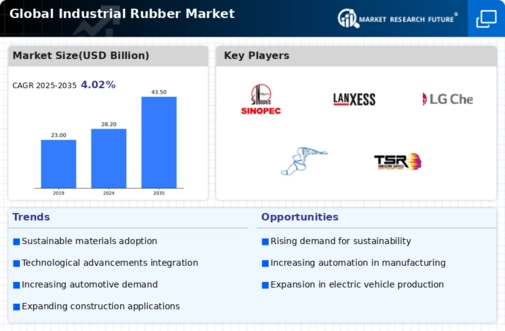Leading market players are investing heavily in research and development to expand their product lines, which will help the Industrial Rubber market grow even more. Market participants are also undertaking various strategic activities to expand their footprint, with important market developments including new product launches, contractual agreements, mergers and acquisitions, higher investments, and collaboration with other organizations. The Industrial Rubber industry must offer cost-effective items to expand and survive in a more competitive and rising market climate.
Manufacturing locally to minimize operational costs is one of the key business tactics manufacturers use in the Industrial Rubber industry to benefit clients and increase the market sector. In recent years, the Industrial Rubber industry has offered some of the most significant advantages to medicine.
Major players in the Industrial Rubber market, including Sinopec (China), LANXESS (Germany), LG Chemical (South Korea), Bridgestone Corporation (Japan), Kumho Petrochemical (South Korea), The Goodyear Tire & Rubber Company (U.S.), JSR Corporation (Japan), ZEON CORPORATION (Japan), Versalis S.P.A. (Italy), TSRC (Taiwan), PJSC "Nizhnekamskneftekhim" (Russia), and others, are attempting to increase market demand by investing in research and development operations.
Kumho Petrochemical Company Ltd., founded in 1970, and located in Seoul, South Korea, is a Korean international company that manufactures synthetic rubbers, synthetic resins, specialty chemicals, energy, electronic chemicals, and advanced materials as core businesses. In June 2018, Kumho Petrochemical announced the NB Latex production capacity expansion from 400 to 550 KT per annum at its manufacturing plant in Ulsan. The spreading is expected to be completed by the first quarter of 2019.
Cabot Corporation, founded in 1882, and located in Boston, Massachusetts, USA, is an American international company specializing in chemicals and performance materials. It operates in over 20 countries with over 30 manufacturing plants, several research & development facilities, and sales offices. In February 2023, Cabot Corporation launched its new E2C DX9660 solution designed to deliver significantly increased rubber durability through high abrasion resistance. The new product provides a 30% increase in abrasion resistance compared to a conventional compound. It expands Cabot's portfolio of E2C solutions for use in a wide range of on-road commercial tire applications and industrial rubber products.
EVOLVE Sustainable Solutions powers Cabot Corporation’s first ever ISCC PLUS certified black masterbatch products introduced by ISCC PLUS certified black masterbatches are made from recycled carbon content according to EN ISO/IEC 17033 as well as ASTM D7856-13 standard requirements. The world does not commonly witness such an occurrence, especially among start-ups, because these firms lack the resources needed for consistency when it comes to supply lines that support recycling efforts within them.
Great news for the recycling industry then when one of the world’s largest suppliers in the plastic industry and a major player in the rubber sector, Cabot Corporation, comes up with sustainable products that can be accepted by manufacturers. The Company announced its products – the REPLASBLAK range of circular black masterbatches, which are supplied with certified material. The firm has just brought three new items to market.
















